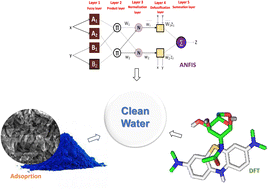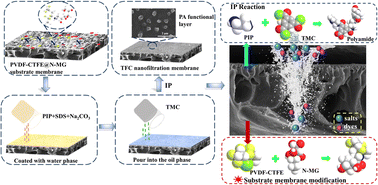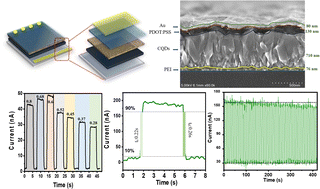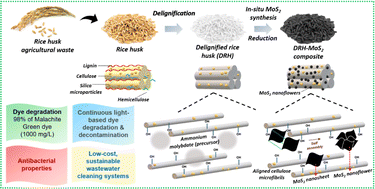
RSC Advances
Subject area
Environmental articles published in the last
6 months

Construction of a novel ternary synergistic CuFe2O4–SnO2-rGO heterojunction for efficient removal of cyanide from contaminated water
Many industrial effluents release cyanide, a well-known hazardous and bio-recalcitrant pollutant, and thus, the treatment of cyanide wastewater is a major challenge.

RSC Adv., 2024,14, 13850-13861
https://doi.org/10.1039/D4RA02217C
Colorimetric detection of Hg2+ based on the enhanced oxidase-mimic activity of CuO/Au@Cu3(BTC)2 triggered by Hg2+
A colorimetric method was designed for Hg2+ detection based on the enhanced oxidase-mimic activity of CuO/Au@Cu3(BTC)2.

RSC Adv., 2024,14, 13808-13816
https://doi.org/10.1039/D4RA01953A
Study adsorbents based on bent-Al13-CS-CTA and its application to the removal of CR from wastewater
For rapid and efficient removal of Congo red (CR) from aqueous solutions, a composite of bent-Al13-CS-CTA was prepared from bentonite (bent), chitosan (CS), citric acid (CTA) and Al13 compounds.

RSC Adv., 2024,14, 13817-13826
https://doi.org/10.1039/D4RA00197D
Selection, characterization, and biosensing applications of DNA aptamers targeting cyanotoxin BMAA
Scientists have established a connection between environmental exposure to toxins like β-N-methylamino-L-alanine (BMAA) and a heightened risk of neurodegenerative disorders.

RSC Adv., 2024,14, 13787-13800
https://doi.org/10.1039/D4RA02384F
Degradation of fluoride in groundwater by electrochemical fixed bed system with bauxite: performance and synergistic catalytic mechanism
This study demonstrates that the coordinated defluorination system (IE-BA) which is made up of the industrial aluminum electrode and natural bauxite for fluoride removal. The defluorination mechanism of the IE-BA system is discussed.

RSC Adv., 2024,14, 13711-13718
https://doi.org/10.1039/D4RA01359J
Determination of moxifloxacin in milk using a ratiometric fluorescent sensor based on Ag-MOF@curcumin
Moxifloxacin (MFX) has attracted increasing public concern recently, and the development of a simple and effective analysis method has become a research focus.

RSC Adv., 2024,14, 13482-13488
https://doi.org/10.1039/D4RA00906A
Dispersive micro solid phase extraction of glibenclamide from plasma, urine, and wastewater using a magnetic molecularly imprinted polymer followed by its determination by a high-performance liquid chromatography-photodiode array detector
The present study describes the development of a simple and selective analytical method for dispersive micro solid phase extraction and determination of glibenclamide (GLB) using magnetic molecularly imprinted polymer (MMIP) as a sorbent.

RSC Adv., 2024,14, 13168-13179
https://doi.org/10.1039/D4RA00452C
Efficient dye adsorption of mesoporous activated carbon from bamboo parenchyma cells by phosphoric acid activation
In this study, mesoporous activated carbon was prepared from bamboo parenchyma cells for MB removal from water.

RSC Adv., 2024,14, 12873-12882
https://doi.org/10.1039/D4RA01652A
Superhydrophobic foam combined with biomass-derived TENG based on upcycled coconut husk for efficient oil–water separation
Ocean ecological environments are seriously affected by oil spilling and plastic-debris, significantly reducing marine pollution via using biocomposite production from natural fiber reinforcement is a friendly way to deal with marine oil pollution.

RSC Adv., 2024,14, 13005-13015
https://doi.org/10.1039/D4RA01841A
Enhanced photocatalytic performance of ZnO under visible light by co-doping of Ta and C using hydrothermal method
C, Ta-co-doped ZnO nanoparticles (Eg = 2.88 eV), prepared by hydrothermal method, were used as a photocatalyst under visible light to remove organic contaminants in aquatic environments.

RSC Adv., 2024,14, 12954-12965
https://doi.org/10.1039/D4RA00579A
Application of cold-adapted microbial agents in soil contaminate remediation: biodegradation mechanisms, case studies, and safety assessments
Analyzed the microorganisms cold-adapted mechanism, and summarized the degradation pathway of nitro-aromatic compounds. Evaluated safety of microbial agents according to the existing application restoration cases under freeze-thaw cycles condition.

RSC Adv., 2024,14, 12720-12734
https://doi.org/10.1039/D4RA01510J
Thermally modified nanocrystalline snail shell adsorbent for methylene blue sequestration: equilibrium, kinetic, thermodynamic, artificial intelligence, and DFT studies
The quest for an efficient and sustainable adsorbent material that can effectively remove harmful and hazardous dyes from industrial effluent has become more intense. Thermally modified nanocrystalline snail shell is a new biosorbent for removing methylene blue dye from contaminated wastewater.

RSC Adv., 2024,14, 12703-12719
https://doi.org/10.1039/D4RA01074D
Amplification of photocatalytic degradation of antibiotics (amoxicillin, ciprofloxacin) by sodium doping in nano-crystallite hydroxyapatite
Sodium-doped hydroxyapatite (Na_HAp) was synthesized for the enhanced photocatalytic degradation of amoxicillin and ciprofloxacin.

RSC Adv., 2024,14, 12386-12396
https://doi.org/10.1039/D4RA00126E
Resistance and durability of fly ash based geopolymer for heavy metal immobilization: properties and mechanism
This study employed geopolymerization technique to solidify MSWI fly ash, aiming to facilitate its reutilization. The FA based geopolymers exhibit strong durability and mechanical qualities, making them suitable for a variety of applications.

RSC Adv., 2024,14, 12580-12592
https://doi.org/10.1039/D4RA00617H
Research on preparation and related properties of macro–micro porous mullite ceramic skeletons via twice pore-forming technology
The macro–micro composite porous mullite ceramic skeletons were prepared using coal gangue and α-Al2O3 as main raw materials via twice pore-forming technology. The main phase of the porous ceramic skeletons is mullite.

RSC Adv., 2024,14, 12624-12632
https://doi.org/10.1039/D4RA01277A
Preparation of N-MG-modified PVDF-CTFE substrate composite nanofiltration membrane and its selective separation of salt and dye
N-Methylglucamine (N-MG) was introduced to poly(vinylidene fluoride-co-chlorotrifluoroethylene) (PVDF-CTFE) porous substrate membrane to enhance its hydrophilicity and permeability, leading to the preparation of a composite NF membrane with selective separation performance for many dyes and salts.

RSC Adv., 2024,14, 11992-12008
https://doi.org/10.1039/D4RA00359D
Synergistic effects of β-NaFeO2 ferrite nanoparticles for photocatalytic degradation, antibacterial, and antioxidant applications
Detailed antibacterial mechanism using by synthesized β-NaFeO2.

RSC Adv., 2024,14, 12513-12527
https://doi.org/10.1039/D4RA02430C
Optimizing methanol synthesis from CO2 using graphene-based heterogeneous photocatalyst under RSM and ANN-driven parametric optimization for achieving better suitability
Assessment of the performance of linear and nonlinear regression-based methods for estimating in situ catalytic CO2 transformations employing TiO2/Cu coupled with hydrogen exfoliation graphene (HEG) has been investigated.

RSC Adv., 2024,14, 12496-12512
https://doi.org/10.1039/D4RA00578C
A self-powered photodetector through facile processing using polyethyleneimine/carbon quantum dots for highly sensitive UVC detection
Ultraviolet C (UVC) photodetectors have garnered considerable attention because the detection of UVC is critical for preventing skin damage in humans, monitoring environmental conditions, and detecting power aging in military applications.

RSC Adv., 2024,14, 12360-12371
https://doi.org/10.1039/D3RA08538D
Synthesis of different types of nano-hydroxyapatites for efficient photocatalytic degradation of textile dye (Congo red): a crystallographic characterization
Exploration of the crystallographic parameters of various nano-hydroxyapatites for enhanced photocatalytic degradation of Congo red dye.

RSC Adv., 2024,14, 11570-11583
https://doi.org/10.1039/D3RA08527A
Kinetic and reactivity of gas-phase reaction of acyclic dienes with hydroxyl radical in the 273–318 K temperature range
The relative position of two C![[double bond, length as m-dash]](https://www.rsc.org/images/entities/char_e001.gif) C on the acyclic dienes could determine its reactivity. The number and type of alkyl group and the number of addition sites on diene could also strongly affect its reactivity toward OH radical.
C on the acyclic dienes could determine its reactivity. The number and type of alkyl group and the number of addition sites on diene could also strongly affect its reactivity toward OH radical.

RSC Adv., 2024,14, 12303-12312
https://doi.org/10.1039/D3RA08750F
Reusable magnetic mixture of CuFe2O4–Fe2O3 and TiO2 for photocatalytic degradation of pesticides in water
Mixture of TiO2-P25 and magnetic CuFe2O4–Fe2O3 nanocomposites improves photocatalytic water treatment and enables easy catalyst recovery, effectively degrading pollutants like 2,4-D.

RSC Adv., 2024,14, 12337-12348
https://doi.org/10.1039/D4RA00094C
Investigation into the impact of CeO2 morphology regulation on the oxidation process of dichloromethane
Four distinct CeO2 catalysts featuring varied morphologies (nanorods, nanocubes, nanoparticles, and nano spindle-shaped) were synthesized through a hydrothermal process and subsequently employed in the oxidation of dichloromethane (DCM).

RSC Adv., 2024,14, 12265-12277
https://doi.org/10.1039/D4RA01326C
Rice husk valorisation by in situ grown MoS2 nanoflowers: a dual-action catalyst for pollutant dye remediation and microbial decontamination
In this study, we carried out valorization of rice husk through in situ growth of MoS2 nanoflowers for simultaneous pollutant dye remediation and microbial decontamination.

RSC Adv., 2024,14, 12192-12203
https://doi.org/10.1039/D4RA00862F
Freezing-enhanced chlorination of organic pollutants for water treatment
Freezing-accelerated chlorination was observed for different organic pollutants and the chlorine/freezing system shows potential feasibility for water treatment in cold environments.

RSC Adv., 2024,14, 12218-12224
https://doi.org/10.1039/D4RA00081A
Browse by Subject
- All (347 articles)
- Atomic/elemental (15 articles)
- Bioanalytical (72 articles)
- Chemometrics (31 articles)
- Crystallography (174 articles)
- Electroanalytical (60 articles)
- Imaging/microscopy (34 articles)
- Mass spectrometry (25 articles)
- Medical diagnostics (84 articles)
- Microfluidics (16 articles)
- Nanoanalysis (21 articles)
- Separation science (27 articles)
- Spectroscopy (97 articles)
- All (277 articles)
- Bioinorganic chemistry (53 articles)
- Bioorganic chemistry (29 articles)
- Biotechnology (46 articles)
- Cellular chemistry (62 articles)
- Computational (88 articles)
- Drug delivery (74 articles)
- Drug discovery (189 articles)
- Imaging/diagnostics (15 articles)
- Molecular biology (7 articles)
- Nanotechnology (40 articles)
- Natural products (30 articles)
- Pharmacology (96 articles)
- Photobiology (17 articles)
- Polymorphism (pharma) (1 article)
- Structural biology (12 articles)
- Toxicology (3 articles)
- All (562 articles)
- Biomaterials (103 articles)
- Biopolymers (99 articles)
- Carbon materials (103 articles)
- Composites (245 articles)
- Electronic materials (92 articles)
- Encapsulation (1 article)
- Energy applications (83 articles)
- Films/membranes (82 articles)
- Gels & soft matter (35 articles)
- Inorganic materials (50 articles)
- Medical materials (66 articles)
- Nanomaterials (126 articles)
- Optical materials (50 articles)
- Organic materials (51 articles)
- Polymers (126 articles)
- All (347 articles)
- Assembly (10 articles)
- Biotechnology (29 articles)
- Carbon nanomaterials (82 articles)
- Imaging/microscopy (15 articles)
- Nanoanalysis (39 articles)
- Nanocatalysis (34 articles)
- Nanomaterials (219 articles)
- Nanomedicine (40 articles)
- Nanotoxicology (51 articles)
- Optical nanomaterials (33 articles)
- Synthesis (13 articles)
- All (185 articles)
- Bioorganic (18 articles)
- Catalysis (46 articles)
- Fine chemicals (27 articles)
- Natural products (25 articles)
- Physical organic (9 articles)
- Stereochemistry (11 articles)
- Supramolecular (3 articles)
- Sustainable synthesis (36 articles)
- Synthetic methodology (108 articles)
- Total synthesis (14 articles)
- All (336 articles)
- Biophysics (2 articles)
- Charge transfer (30 articles)
- Electrochemistry (12 articles)
- Energy research (19 articles)
- Imaging/microscopy (6 articles)
- Kinetics & dynamics (43 articles)
- Materials (108 articles)
- Mechanics (34 articles)
- Nanoscience (73 articles)
- Photoscience (29 articles)
- Quantum & theoretical (95 articles)
- Simulations (23 articles)
- Single molecules (46 articles)
- Soft matter (5 articles)
- Spectroscopy (7 articles)
- Surfaces & interfaces (73 articles)